Growing tamarind from seed can be a rewarding experience for gardening enthusiasts. The process requires patience and attention to detail, as tamarind trees take time to grow and mature. This document will discuss the steps involved in growing tamarind from seed and explore the time it takes for the seeds to develop into fully-grown tamarind trees.

How to Grow Tamarind from Seed
Understanding the Tamarind Tree and Its Seeds
Tamarind trees are medium-sized to large trees, reaching heights of 80 feet or more. It has a wide, spreading crown and a thick, sturdy trunk. The tamarind tree leaves are pinnate, arranged in pairs along a central stalk. They are dark green and give the tree a lush appearance. One of the most fascinating aspects of the tamarind tree is its seeds. The seeds are contained within the fruit and are surrounded by a sticky pulp. These seeds are hard and shiny and have a smooth, dark brown color. They are oval-shaped and about the size of marble.
Selecting and Preparing Tamarind Seeds for Planting
When selecting tamarind seeds for planting, choosing viable and healthy seeds is crucial. Look for dark brown or black seeds with a smooth and shiny outer shell. Avoid seeds that have cracks or visible damage. Opt for seeds that are plump and heavy. Larger seeds tend to have a higher chance of germination.
Preparing Tamarind Seeds for planting
Fill a mug with hot water and soak the seeds for one hour. Use safety glasses and gloves when you soak the seeds in boiling water. The seeds can also be prepared by soaking them in water for 12 to 24 hours. Then these soaked seeds should be planted 1/2 inch deep in potting soil (compost, garden soil, coco peat) and covered slightly with the same soil. Make sure they are well hydrated. Cover the whole container with plastic wrap.
Creating the Ideal Growing Environment for Tamarind Seeds
Sunlight: Ideally, tamarind trees should be exposed to full sunlight for at least 6 to 8 hours a day. Make sure the tree receives ample sunlight throughout the day by choosing a location where it can receive it.
Climate: They thrive in tropical and subtropical climates. They require temperatures between 25°C and 35°C for optimal growth.
Soil Requirement: It is possible to grow tamarind plants in any soil. It is capable of growing even in alkaline and salty soil. It grows best in fertile, loamy soil. This type of soil is conducive to developing its long, deep roots.
In case you missed it: How to Grow and Care for Tamarind Bonsai: Planting, Pruning, and Repotting

Planting Tamarind Seeds in Containers or Directly in the Ground
Is Tamarind Hard to Grow? Absolutely NO. It is relatively easy to grow tamarind from seed as long as the seeds are pretreated before planting. Below are the best practices if you don’t know how to plant tamarind seeds. Ideally, soak the tamarind seeds in warm water for 24 hours. As a result, the seed coat will become softer, and germination will be improved. Fill the 12-inch container with potting mix, leaving about an inch of space at the top.
The soaked tamarind seeds should be planted about an inch deep in the soil, spaced at least three inches apart. Maintain an even moisture level, but do not let it become soggy. The soil in the container should be watered whenever the top inch feels dry. The root system can rot if it is overwatered. Ensure the tamarind tree is placed in a sunny location where it receives at least 6 to 8 hours of direct sunlight daily. Plant the seedlings directly into the ground or larger containers once they have reached 6 to 8 inches in height and developed some leaves.
Providing Optimal Watering and Drainage for Tamarind Seedlings
Tamarind seedlings should be watered regularly, especially during the initial stages of growth. Aim to water them every 2-3 days, providing sufficient moisture without causing waterlogging or drought stress. To ensure effective watering, direct the water towards the base of the seedlings, allowing it to penetrate the soil deeply.
Avoid wetting the foliage excessively, as this can lead to fungal diseases. To promote adequate drainage, use a well-draining soil mix for tamarind seedlings. A good mixture often consists of organic matter, such as vermicompost or peat moss, and a mineral component, like perlite or sand. This mixture helps prevent waterlogging and allows excess water to drain freely.
If growing tamarind seedlings in containers, ensure they have proper drainage holes at the bottom. This allows excess water to escape, preventing water accumulation in the container. Raising the containers on a platform or adding a gravel layer at the bottom can further enhance drainage.
Nurturing Tamarind Seedlings With Proper Sunlight and Temperature
These seedlings require full sun exposure to thrive. It is recommended to place them in an area where they can receive at least 6-8 hours of direct sunlight each day. This will provide them with the necessary energy for photosynthesis, promoting leaf growth and overall health. If you are growing tamarind seedlings indoors, consider using artificial grow lights to mimic natural sunlight.
In case you missed it: Frequently Asked Questions About Tamarind Farming

In addition to sunlight, temperature is another vital factor in nurturing tamarind seedlings. Tamarind seedlings prefer warm temperatures between 20-30°C. Avoid exposing them to extreme cold or hot temperatures, as this can stunt their growth or even cause damage. If you are growing tamarind seedlings in a colder climate, consider using a greenhouse or providing additional heat sources to maintain the desired temperature range.
Fertilizing and Pruning Tamarind Trees for Healthy Growth
Choosing the Right Fertilizer: To provide the necessary nutrients, selecting the appropriate fertilizer for tamarind trees is important. A fertilizer with an NPK ratio of around 8-3-9 is recommended. Slow-release fertilizers work well for tamarind trees as they provide a steady supply of nutrients over an extended period.
Fertilization Schedule: Tamarind trees should be fertilized twice yearly, preferably in early spring and late summer or early fall. The application rate depends on the age and size of the tree.
Applying Fertilizer: Spread the fertilizer evenly around the tree’s drip line, avoiding direct contact with the trunk. Gently work the fertilizer into the soil surface with a tiller and water thoroughly after application.
Pruning
- Remove dead, diseased, or broken branches using clean, sharp pruning shears. Make clean cuts outside the branch collar without leaving stubs.
- Overcrowded branches should be done to improve air circulation and light penetration. Remove weak or crossing branches that may rub against each other, as they can create wounds that invite pests and diseases.
- Maintain a central leader or a balanced framework of scaffold branches to promote a strong tree structure.
Protecting Tamarind Seedlings from Pests and Diseases
Pest Control: Monitor your tamarind seedlings regularly for signs of pest infestation. Common pests that affect tamarind seedlings include aphids, caterpillars, mealybugs, and scales. If you notice any pests, consider using organic pest control methods like introducing beneficial insects, like ladybugs, lacewings, insecticidal soaps, or neem oil sprays.
Disease Management: Tamarind seedlings can be susceptible to various diseases, including root rot and powdery mildew. To prevent these diseases, provide proper air circulation by spacing the seedlings adequately. Avoid overhead watering, as it can promote fungal growth. If necessary, apply fungicides recommended for tamarind seedlings as a preventive measure.
Transplanting Tamarind Seedlings Into Larger Containers or the Ground
- If your tamarind seedlings are in smaller containers, gently remove them from their pots. Carefully loosen the roots by gently massaging the root ball with your hands.
- Choose containers at least 2-3 times larger than their current pots. They should have drainage holes to prevent waterlogging.
- Fill the larger containers with a well-draining potting mix, leaving enough space at the top to accommodate the seedlings.
- Create a small hole in the center of the container and gently place the tamarind seedling into it. Ensure the root ball is covered with soil, leaving the stem above the surface.
- After transplanting, thoroughly water the tamarind seedlings, ensuring the soil is evenly moist.
How Long Does It Take to Grow Tamarind from Seed?
Growing tamarind from seed can be a time-consuming process. From the time you plant the seed until you can harvest the tamarind fruit, it typically takes around 5 to 8 years. The germination of tamarind seeds is relatively long, ranging from 30 to 45 days. Once the seed has germinated, the tamarind tree will take several years to reach maturity and produce fruit. The exact time it takes for the tamarind tree to bear fruit may change depending on the climate, soil conditions, and care provided.
In case you missed it: How to Grow Capsicum from Seeds: How Long Does it Take to Grow Capsicum from Seed?

Conclusion
In conclusion, growing tamarind from seed requires patience and care. However, with the right conditions and proper nurturing, you can enjoy the delight of growing your tamarind tree from seed.
- Feed Your Flock for Less: Top 10 Tips to Save on Chicken Feed
- Ultimate Guide to Ossabaw Island Hog: Breeding, Raising, Diet, and Care
- Hatching Answers: The Top 10 Reasons Your Chickens Aren’t Laying Eggs
- Eggs and Economics: Breaking Down the Cost of Raising Backyard Chickens
- Defend Your Greens: Proven Methods to Keep Iguanas Out of Your Garden
- Ultimate Guide to Cinnamon Queen Chicken: A Comprehensive Guide for Beginners
- Ultimate Guide to California Tan Chicken: Breeding, Raising, Diet, Egg-Production and Care
- Ultimate Guide to Marsh Daisy Chicken: Breeding, Raising, Diet, and Care
- 10 Types of Chicken Farming Businesses You Can Start for Profits